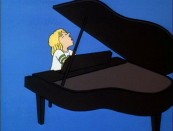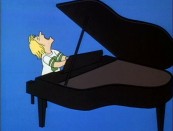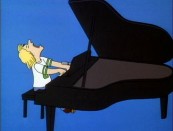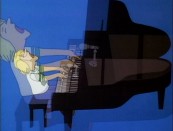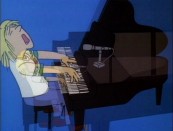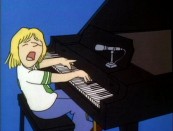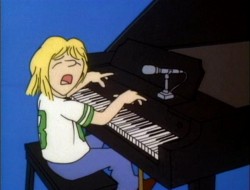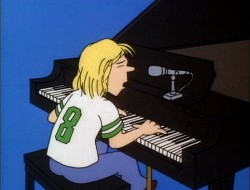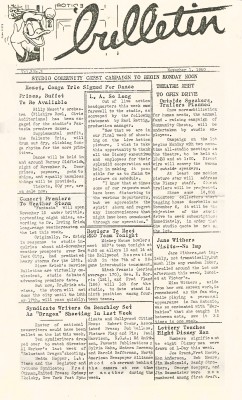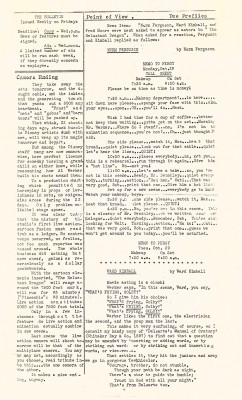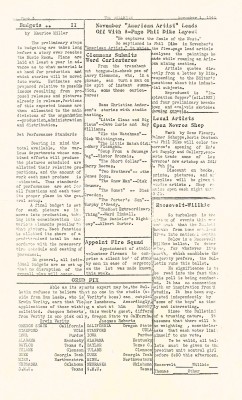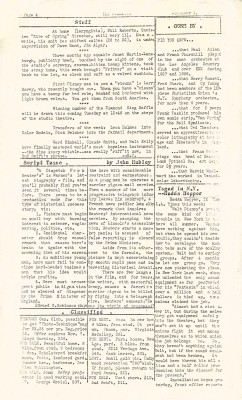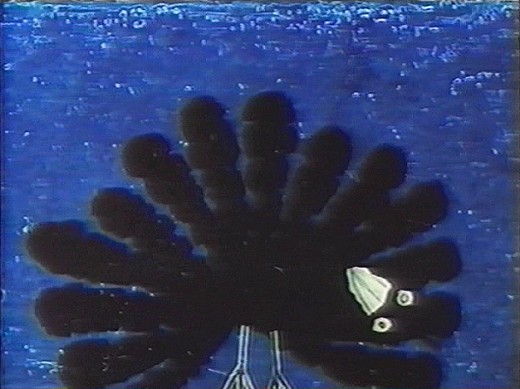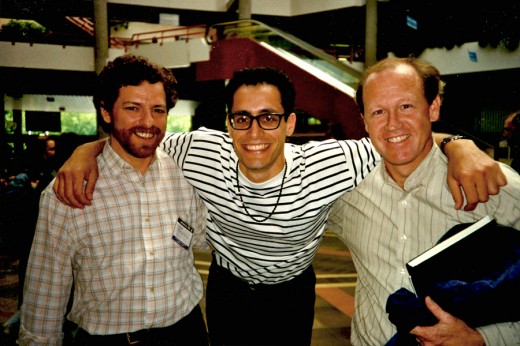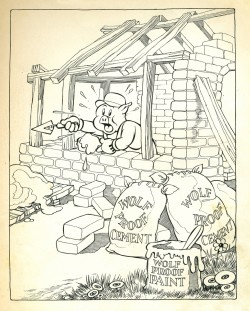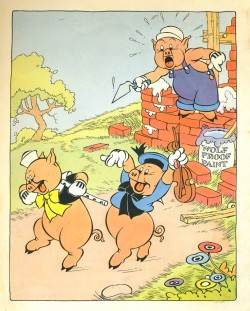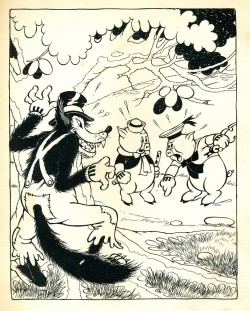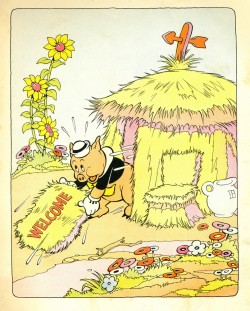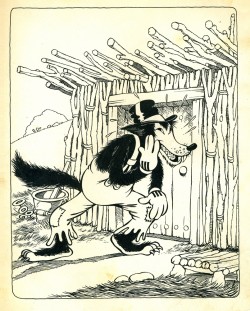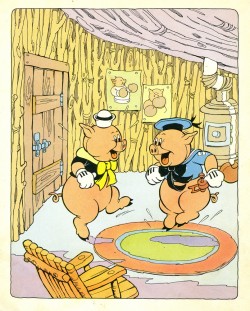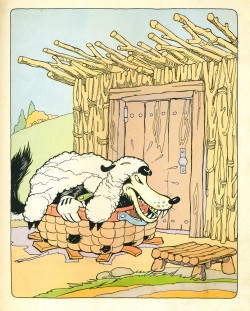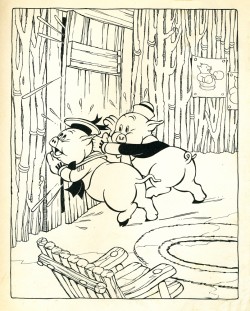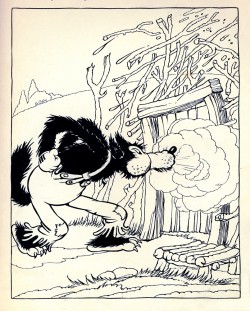Monthly ArchiveFebruary 2007
Animation Artifacts &Books &Luzzati & Gianini 08 Feb 2007 07:59 am
Luzzatti Monograph
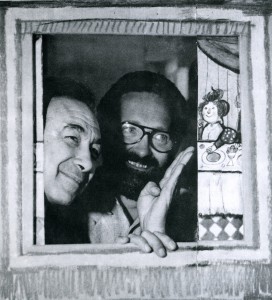 – Continuing my series on Emanuele Luzzati, who died last Thursday, I want to point some attention to an Italian monograph, published in 1983, on Luzzati and his partner, Giulio Gianini.
– Continuing my series on Emanuele Luzzati, who died last Thursday, I want to point some attention to an Italian monograph, published in 1983, on Luzzati and his partner, Giulio Gianini.
This book by Sara Cortllazzo is Pastelli Pupazzi e Siparietti, Il Cinema di Gianini e Luzzati. Its primary usefulness is the complete filmography which makes up the latter half of the book.
(You can read a digital translation of Gianni Rondolino’s introduction to this here.)
The book is illustrated with a number of B&W frame blow ups from the films. There are a couple of original pieces which I post here:
Luzzati on the left, Gianini on the right.
(All images enlarge by clicking them.)
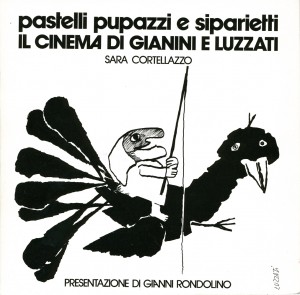 2
2 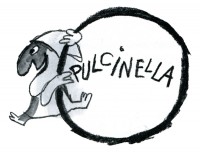 3
3
2. The book’s cover features the Thieving Magpie ridden by Pulcinella, their two Oscar nominees.
3. This is a small sketch of Pulcinella (Punch) from the film Pulcinella.
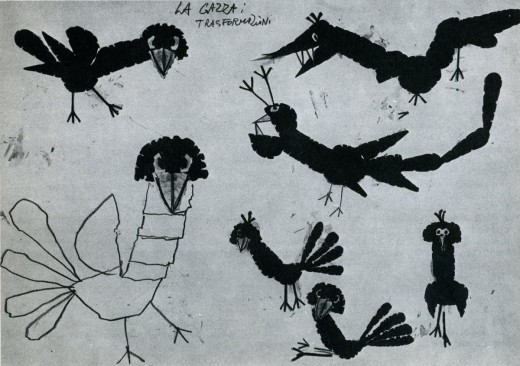
A model for the magpie from The Thieving Magpie.
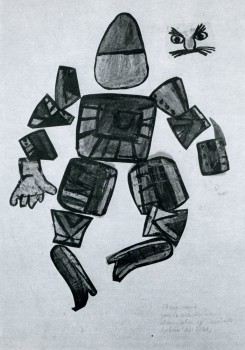 5
5 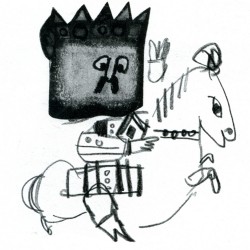 6
6
5. A character sheet from their short, Ali Baba. You can see exactly how the pieces will be cut and reconstructed to animate the character under the camera. (Not too far from Flash.)
6. A character sketch from the short, The Paper Castles.
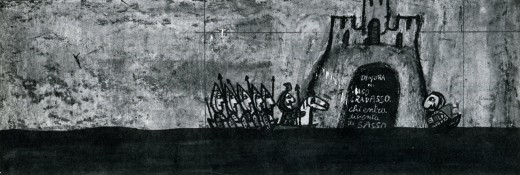
A background setup from The Paladins of France.
Daily post &Hubley &Tissa David 07 Feb 2007 08:16 am
Doonesbury
- The 1977 Hubley film of Gary Trudeau‘s Doonesbury Special has just shown up on YouTube. It comes in five parts. This is the film that was the last started by John Hubley.
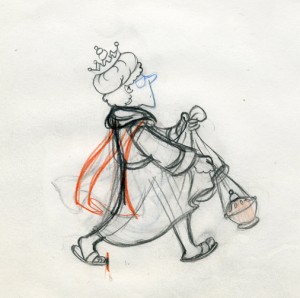 The Hubley Studio was an apartment on the Upper East Side of Manhattan. It was always crowded with beautiful, framed art: paintings by John and Faith, Backgrounds from their films, and the more attractive awards given to them.
The Hubley Studio was an apartment on the Upper East Side of Manhattan. It was always crowded with beautiful, framed art: paintings by John and Faith, Backgrounds from their films, and the more attractive awards given to them.
Stepping into the apartment/studio was like stepping into an art gallery brimming with modern art. I always felt like I should be whispering.
Fresh off Raggedy Ann & Andy, I was brought on board the show to assist John. I had missed the prior 18 months while John was in London working on and getting over the Watership Down debacle. ***
(One of Tissa’s 24 drawing walk cycle. Someday I’ll
post them all with rougher preliminary sketches.)
Returning to the studio was both a joy and a shock. All that great art, had Doonesbury strips ripped out of the newspapers and taped over all the framed Hubley art. I found it embarrassing given how great the art was underneath those strips.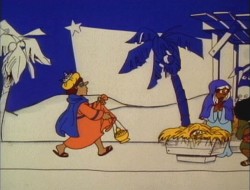
The show was just barely getting started. Actors had just started recording. John, Faith and Gary spent many of their days at the studio recording while I started development of the film’s art from the storyboards.
Kate Wodell, one of Hubley’s talented ex-students from Yale who had worked through Everybody Rides the Carousel, was the only other person on staff; I think she started a few days after me.
(Click any image to enlarge.)
Gary and I didn’t really speak more than to say hello, but it was obvious that he and I didn’t really get along. John strongly held onto me, and wouldn’t alow me to leave or be left.
However, about a month into the work, he called me to his room. John told me that he had to lay me off for a couple of weeks. He was about to go into the hospital for an operation up at Yale, and would halt work until his return.
John Hubley didn’t return. He died on the operating table.
After a short period, Faith announced that they would finish the film in John’s honor, and she and Gary Trudeau would direct in tandem. I decided not to return. I took a job assisting R.O.Blechman direct his first one-hour special, Simple Gifts.
About a month into my work, I got a call from Tissa David. She was animating the class play in the Doonesbury Special, and she needed help. She couldn’t find an assistant who could keep up with her on the schedule she had to meet for them. About 100 feet a week of pretty full animation.
I agreed to work free lance on Tissa’s work for Faith. During the day I was an Asst. Director on one PBS Special; at night I was an Asst. Animator on another CBS Special. When I completed Tissa’s scenes – about a month’s work – I got a call from Kate Wodell. Ruth Kissane had animated a piano rotating 90 degrees with a character playing the piano on another level, but she’d left many of the drawings for an assistant. No one at the Hubley studio could do it, and they asked if I would help out. I did the scene which took about a week.
Unfortunately, that was the last time I worked for Faith, even though we remained close up to her death.
(This is Ruth Kissane‘s sequence. I have the original drawings somewhere and
I’ll eventually post them.)
*** (I’m sorry this was not written clearly. I do not think Watership Down, the film, was a debacle. John Hubley’s involvment with the film and his treatment by Producer, Martin Rosen, was. See my comment below.)
Animation Artifacts 06 Feb 2007 07:50 am
Bulletin
- Here’s another of the Disney in-house publications. It’s an issue just prior to the last one I posted (here). The Fantasia premiere is up and coming, and there’s plenty of talk about it. The Reluctant Dragon is completing its live action shoot, and Norm Ferguson and Ward Kimball talk about the experience. John Hubley reviews a film, and Joe Grant, Fred Moore and Jim McDonald get their lottery numbers for their military service.
Read all about it.
Animation Artifacts &Luzzati & Gianini 05 Feb 2007 07:53 am
The Thieving Magpie
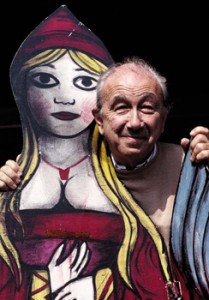 – Last Saturday, I sought some stills from the films of Emanuele Luzzati who died on Friday. I wanted to illustrate a piece I was writing reporting his death. The web offers little by way of illustration of the brilliant artist’s work.
– Last Saturday, I sought some stills from the films of Emanuele Luzzati who died on Friday. I wanted to illustrate a piece I was writing reporting his death. The web offers little by way of illustration of the brilliant artist’s work.
I’ve been something of a fan of the films of Luzzati and Gianini. As I said Saturday, I’d met Luzzati at a function thrown at the Italian Embassy in New York, years ago. I bought a book by him, and the artist drew a beautiful pen and ink drawing in the frontispiece of the book.
In 1988, I met Giulio Gianini in Italy following which I spent a couple of pleasant days with an assistant of his at the festival in Treviso, Italy.
As a bit of a memorial, since I think this was an important artist who died, I’ve decided to post some illustrations and information about the duo with a lot of frame grabs from a number of the Luzzati/Gianini films. This will take a couple of posts so be prepared this week for a bit of Italian artwork.
It seems appropriate to start with The Thieving Magpie, the first of their films to receive an Oscar nomination.
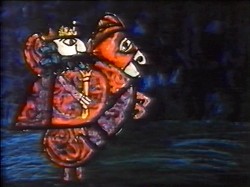 1
1 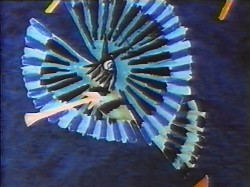 1
1
(Click any image to enlarge.)
The opera is about a young maidservant who, accused of stealing a silver spoon, is sentenced to death for her crime. At the eleventh hour, the real culprit is found to be a magpie. A cartoon, if ever there was one. With great music!
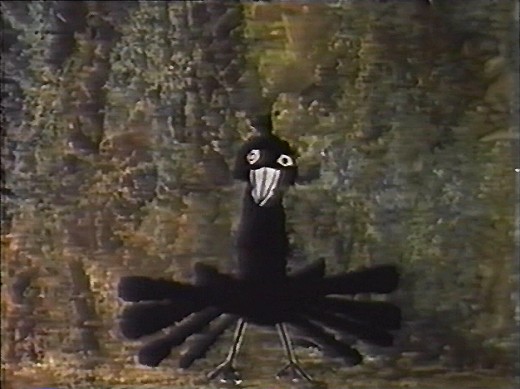
The film tells a tale wherein a king and his hunters, on a bird hunt, are beaten by a magpie who steals their gems and ultimately destroys their village.
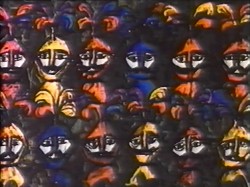 4
4 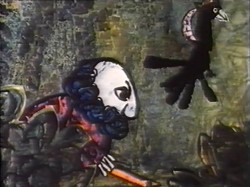 5
5
Luzzati who spent many years designing operas and ballets, brought his knowledge to animation as the pair adapted several operas often utilizing the overtures of the operas they were adapting.
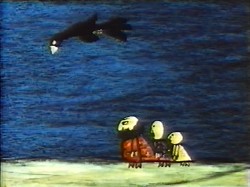 6
6 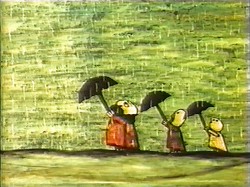 7 The film was nominated in 1964 along with Clay, and the Origin of the Species by Eliot Noyes and the winner, Chuck Jones’ Dot and the Line.
7 The film was nominated in 1964 along with Clay, and the Origin of the Species by Eliot Noyes and the winner, Chuck Jones’ Dot and the Line.
The Sound of Music won the Best Picture Oscar, that year.
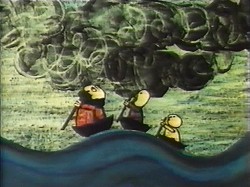 8
8 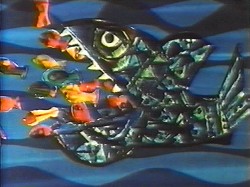 9 The use of cut-out animation wasn’t mainstream at the time. This is years before Terry Gilliam made it somewhat fashionable. All of the Luzzati-Gianini films were totally inventive and creative within the form they established. Gianini’s animation was as dreamlike as Luzzati’s exciting designs. The films look to be designed somewhere between Chagall, Kirchner and stained-glass windows; the sensibilities are all Luzzati and Gianini.
9 The use of cut-out animation wasn’t mainstream at the time. This is years before Terry Gilliam made it somewhat fashionable. All of the Luzzati-Gianini films were totally inventive and creative within the form they established. Gianini’s animation was as dreamlike as Luzzati’s exciting designs. The films look to be designed somewhere between Chagall, Kirchner and stained-glass windows; the sensibilities are all Luzzati and Gianini.
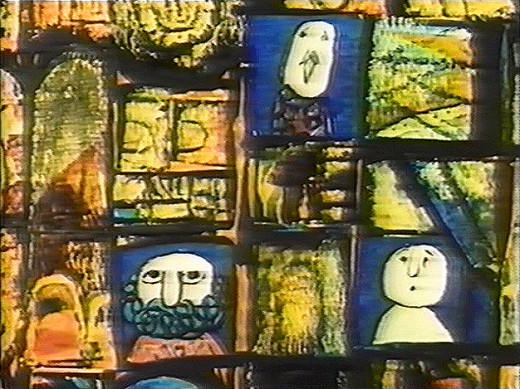 Today we have Flash animation which does just about the same thing as cut-out animation, but the form used is flat and cartoony. It might be useful for practitioners of Flash to take a good look at what these two brilliant designer/animators did with a similar form under more complex methods. Ulltimately, it’s all related.
Today we have Flash animation which does just about the same thing as cut-out animation, but the form used is flat and cartoony. It might be useful for practitioners of Flash to take a good look at what these two brilliant designer/animators did with a similar form under more complex methods. Ulltimately, it’s all related.
Photos 04 Feb 2007 09:24 am
Annecy Photo Sunday
 - How many times have I been to Annecy? Maybe ten. How many pictures do I have of the times there? Not too many. I always thought of the time in terms of food (oddly I always think of Ottawa in terms of films I’ve seen.)
- How many times have I been to Annecy? Maybe ten. How many pictures do I have of the times there? Not too many. I always thought of the time in terms of food (oddly I always think of Ottawa in terms of films I’ve seen.)
One year was a bit different than others. It was about 1992; I was there alone and spent a lot of time floating about by myself. I got to meet a lot of older, more established masters such as Jan Lenica, George Schwizgebel, Rein Raamat, and Gene Deitch. I spent some time with a number of Brits who were there. It was the first time I’d met the folks from Aardman (not Nick Park who hadn’t risen to glory yet) as well as folk from TVC: Dave Unwin and John Coates.
The Americans weren’t into food. They would make sure to buy loaves of bread to take into screenings to eat. It had been a different experience for me in the past – lots of good meals in great restaurants. I ended up straddling two worlds that festival and had an original experience doing it.
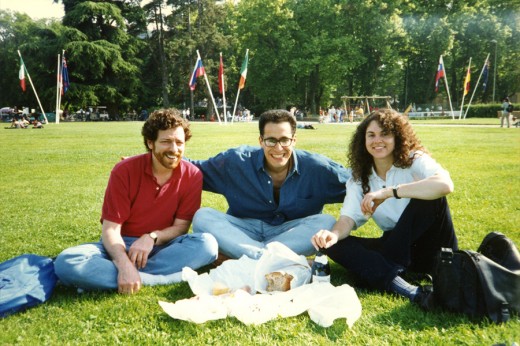 John Dilworth and Linda Simensky were two friends from NY who were the main anchor for me. Here having a rest between films with a picnic.
John Dilworth and Linda Simensky were two friends from NY who were the main anchor for me. Here having a rest between films with a picnic.
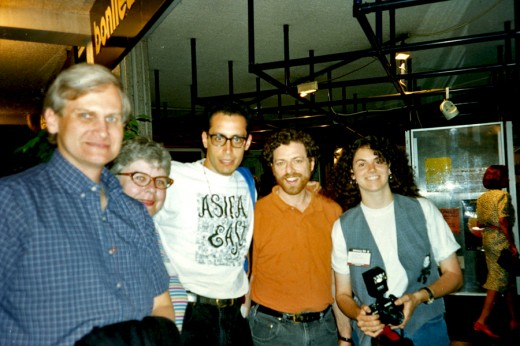
Paul Glabicki‘s films have always been something of an inspiration for me, so it was great meeting him (on the left). Hélène Tanguay, of the NFB, stands next to him. Also: John D, me, and Linda.
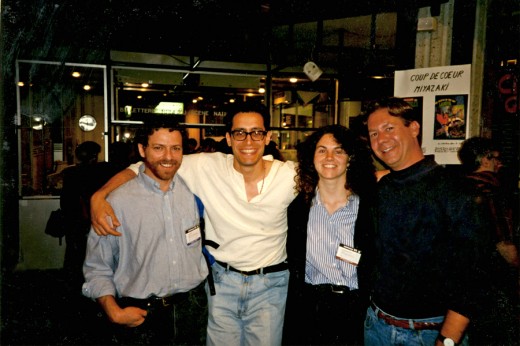 The three musketeers with Abby Terkuhle from MTV.
The three musketeers with Abby Terkuhle from MTV.
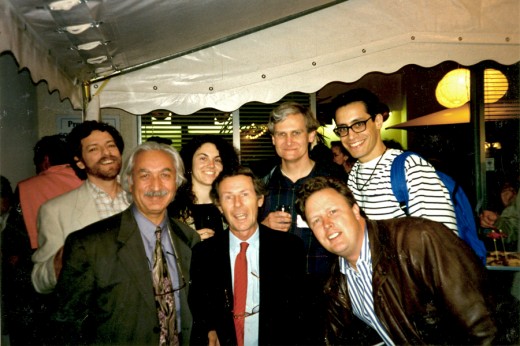 Here at the closing party: Back row L to R: Me, Linda, Paul Glabicki, Dilworth.
Here at the closing party: Back row L to R: Me, Linda, Paul Glabicki, Dilworth.
Front row: Nourredin Zarrinkelk the Iranian ASIFA board member, Bruno Bozzetto, and Terry Thoren.
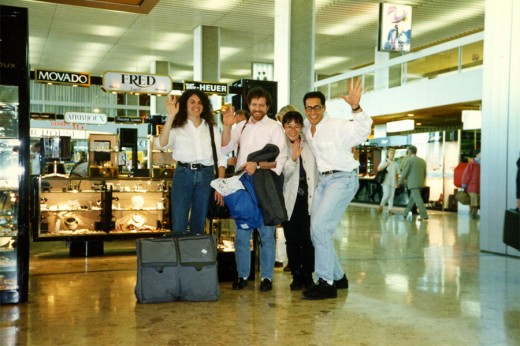 At the airport, the four of us had the same flight. Linda Simensky, me, Masako Kanayama and John Dilworth.
At the airport, the four of us had the same flight. Linda Simensky, me, Masako Kanayama and John Dilworth.
Animation Artifacts &Luzzati & Gianini 03 Feb 2007 08:27 am
Emanuele Luzzati
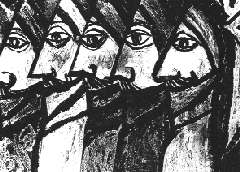 Emanuele Luzzati has died. He was the brilliant Italian designer, who worked with Giulio Gianini in creating some wonderful animated cut-out films.
Emanuele Luzzati has died. He was the brilliant Italian designer, who worked with Giulio Gianini in creating some wonderful animated cut-out films.
Their films adapted operatic overtures in reworking the operas themselves. The two were nominated for the Oscar for “The Thieving Magpie,” done in 1965 an interpretation of Rossini’s opera and again in 1973 for “Pulcinella.”
Luzzati died Jan. 26th, 2007 on the way home from work. He collapsed just outside his home. He hadn’t been ill prior to this. He spoke on the phone with Giulio Gianini, who has been very ill for some time, that very morning.
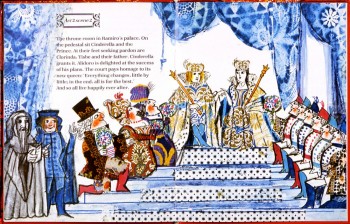 Luzzati designed sets and costumes for stage productions and operas, including the 1963 production he designed for Mozart’s “The Magic Flute.” Fifteen years later he turned the opera into an animated feature that remains one of his most famous works.
Luzzati designed sets and costumes for stage productions and operas, including the 1963 production he designed for Mozart’s “The Magic Flute.” Fifteen years later he turned the opera into an animated feature that remains one of his most famous works.
He’s illustrated and written quite a few books. See this list on Amazon.
(Above: an image from his children’s book, Cinderella.)
The only Obituary I’ve seen for him was this one for the AP. It does give rather complete details of his life and work. AP Obituary.
I got to meet Mr. Luzzati years ago at a function given by the Italian Embassy in his honor. He signed a copy of his book by drawing a beautiful drawing for me (which is currently in storage). Someday I’ll post it.
As someone who loves the combination of animation with music, I have long had an enormous fondness for the works of Luzzati and Gianini. It was an honor to have met him and I continue to appreciate his films. My regret his never having seen one of the many operas he designed.
His work is wildly colorful and beautifully designed. I wish I had on hand some of his images in color. I will have some images later this week and will post them. It’s amazing how little there is about him on line.
You can get a bit more information about Luzzati and Gianini from the website to the Luzzati Museum.
Art Art &Daily post &Illustration 02 Feb 2007 08:10 am
Gallery
- Thanks to George Griffin for directing me to a couple of gallery shows in NYC that include animation work. They’re worth seeing for the rules they break, if nothing else. Though there are inspired moments in it. Like sitting through the recent films of Jean Luc Godard, I have a hard time staying awake, but I always walk away inspired, refreshed and excited by the thoughts on the screen.
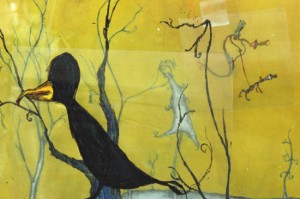 - The Bellweather Gallery features Brent Green. This show features wildly mixed media in a number of pieces, the longest of which is “Paulina Hollers” at 12 minutes. Using everything from magic markers on glass to 3D stop-motion animation he creates films that have all to do with death.
- The Bellweather Gallery features Brent Green. This show features wildly mixed media in a number of pieces, the longest of which is “Paulina Hollers” at 12 minutes. Using everything from magic markers on glass to 3D stop-motion animation he creates films that have all to do with death.
Bellweather Gallery at 134 Tenth Avenue.
This show closes tomorrow, Feb. 3. See it right away.
These are capsule reviews in the New York Times, The New Yorker, and the Village Voice.
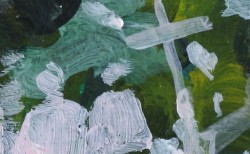 - The Marianne Boesky Gallery has an exhibition of work by Jacco Olivier. This show isn’t quite as impressive and far less inspiring, more like watching paintings progressing to their conclusion shot in stop-motion.
- The Marianne Boesky Gallery has an exhibition of work by Jacco Olivier. This show isn’t quite as impressive and far less inspiring, more like watching paintings progressing to their conclusion shot in stop-motion.
The gallery is located at 509 West 24th Street, between 10th and 11th Avenues. Tues to Sat, 10am to 6pm. (212) 680-9889.
You can view some stills of the artwork at the Gallery’s site.
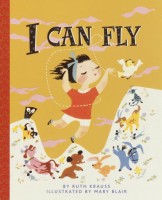 – For those Mary Blair fans out there, story artist and animator, Fred Cline, has posted a commercial from the 50′s that uses designs Mary Blair created for a Little Golden Book called I Can Fly.
– For those Mary Blair fans out there, story artist and animator, Fred Cline, has posted a commercial from the 50′s that uses designs Mary Blair created for a Little Golden Book called I Can Fly.
The commercial was done at TV Graphics, Inc. in New York and was supervised by Lee Blair, Mary’s husband. The commercial is for Milk, but Cline says he has a second for ice cream.
See the spot here.
The book can still be purchased through Random House.
Hardcover $12.95, Paperback $4.95.
(I first found this info on Drawn posted by Ward Jenkins.)
If you’ve watched The Family Guy sequence which rips off the sequence from Anchors Aweigh, you owe it to yourself to go back and watch the original with Jerry the mouse. The original was animated by Ken Muse and Ray Patterson.
Both versions depended on rotoscoping. The original rotoscoped Gene Kelly’s dance to match it with Jerry; The Family Guy rotoscoped Jerry to cover him up with the same animation redone featuring their character, Stewie. More Happy Feet.
Animation Artifacts &Illustration 01 Feb 2007 08:24 am
Three Little Pigs That Could
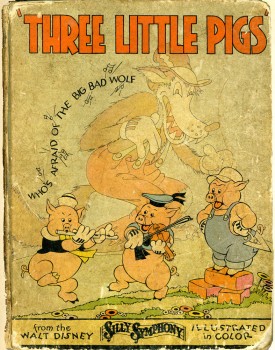 – One of the great, classic cartoons in the Disney canon is The Three Little Pigs. This animated short Silly Symphony was a very big item in its day. Its popularity came close to rivalling Mickey Mouse, and its theme song Who’s Afraid of the Big Bad Wolf was an overwhelming hit. It’s hard to remember this when watching the innocent, little original film.
– One of the great, classic cartoons in the Disney canon is The Three Little Pigs. This animated short Silly Symphony was a very big item in its day. Its popularity came close to rivalling Mickey Mouse, and its theme song Who’s Afraid of the Big Bad Wolf was an overwhelming hit. It’s hard to remember this when watching the innocent, little original film.
There were three follow-up shorts featuring the same characters, though none of them really had much of an impact. The film had widespread cross-promotional success (sheet music sales, dolls, books, etc.) and was a big money-earner for the studio.
Even today you can find a recently constructed flash animated version of the characters on one of the Disney sites.
It’s always been said that this was the first real brakthrough for character animation. By featuring three almost identical characters, the Disney artists had set a chore for themselves trying to differentiate between each of the three pigs. It was a resounding success, and the rubber hose characters were left behind. After the popularity of this short, Disney put even more emphasis on character development and construction.
I have a number of pieces from that period that I thought I might share.
The first is this children’s book adapted from the film and published in 1933. It’s big enough that I’ll have to break it up into two separate posts. Here’s the first part:
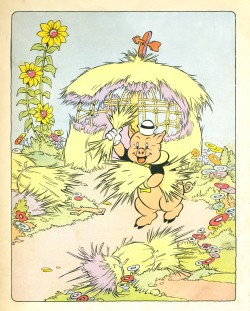 1
1 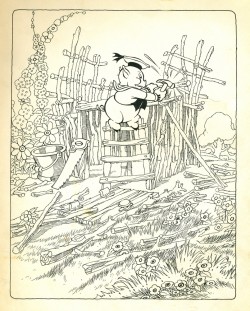 2
2
(Click on any image to enlarge.)
- A post note. Just today, Cartoon Brew talks about a cartoon sequence in a 1963 live action South American film, Cri-Cri el Grillito Cantor. The film features an animation sequnce directed by Bill Justice and X. Atencio. The sequnce can be seen on Didier Ghez‘ site posted last November. The pigs are alive in some form or other.
